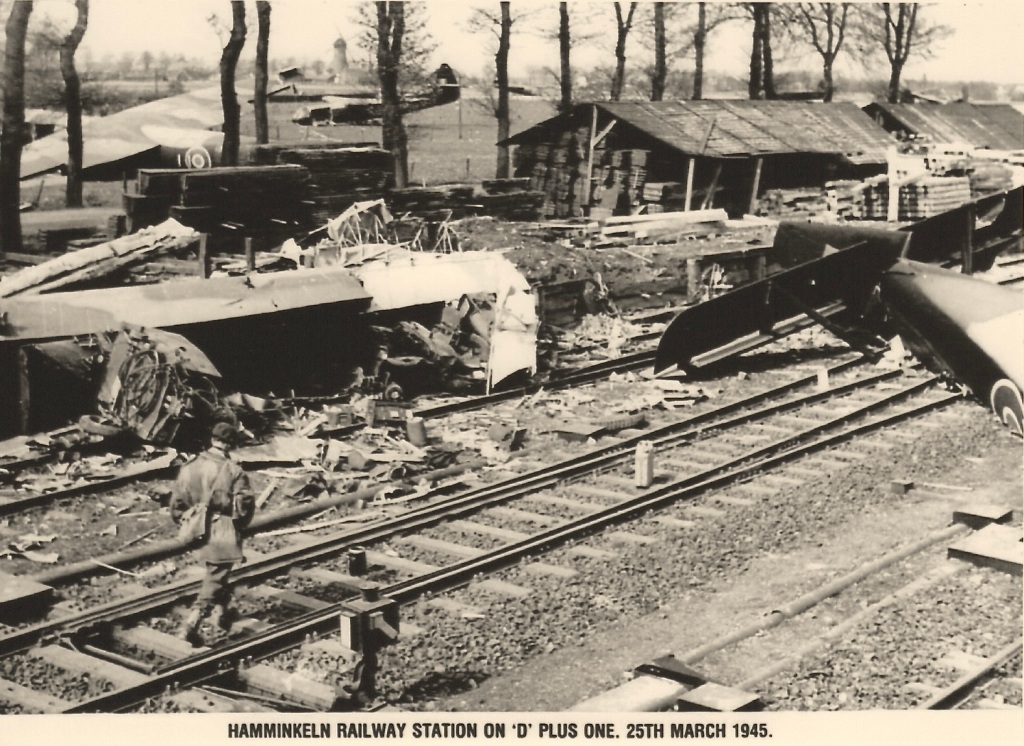Brian Latham, 96, remembers flying a glider over the Rhine in Operation Varsity in 1945, the last and largest airborne assault of the Second World War 75 years ago today.
‘It was probably the most exciting and frightening day of my life.’
Our landing zone was by Hamminkeln station. In this photograph, you can see the station on the right, and my glider behind the trees. I’d just banged it into the ground. The crashed glider on the tracks in front – my friend Jameson was in that one. We lost so many on my squadron that day.

I was a 20-year-old RAF pilot, hoping to fly Spitfires when I was seconded to The Glider Pilot Regiment. They’d lost so many pilots at Arnhem (in September 1944) that RAF pilots were to volunteer for glider duties. Initially, very few volunteered. Then we were told if we didn’t we’d either go in the infantry or down the mines – we’d never fly again. So we became voluntary conscripts and very bolshie.
The Regiment was considered a Corps d’Elite, on a par with Commandoes and Special Forces
We trained hard for what we knew would be a crossing over the Rhine. In a short time, we learnt to handle the Horsa (glider) under all conditions and to operate with any of the troops we may carry, as airborne infantry. God, we were fit in those days – I couldn’t even walk up to the town now.
We’d won our Red Berets and on March 23rd, we loaded the glider, put our possessions in bags to be sent home in case we did not return and wrote letters. I don’t think any of us expected to come back.
Takeoff was at 0600 on March 24th from Gosfield, Essex. My load was a mortar section of the Oxfordshire and Buckinghamshire Light Infantry – one officer and seven men with their jeep, trailer and a motorbike. The Dakotas (our tow planes) taxied onto the runway, and the cables were attached first to them and then to us. We were to be the first squadron to land, and my brand new Mark 2 Horsa glider was Number 14 to go. The station personnel lined the runways and waved us off.

Dakotas filled with Paras passed underneath us and plenty of fighters milled around to discourage enemy aircraft in the four hours of flying, before the navigator in our Dakota said, ‘You’ve got another half mile to go. Okay chaps, look after yourselves.’ At 2,500 feet, we were released and once you’d come off the cable that was it – down, down.
There was no time to think. The flak was very heavy – you could’ve got out and walked on it.
There were gliders going down, there were Dakotas going down. The smoke was just like fog. So we just had to go down through it and hope that we’d see something at the end. We were hit very badly. A shell came into the cockpit and blew the air bottle, which operated our flaps and brakes. Then we were hit in the right wing and lost a wheel.
We were going at a hell of a rate when we landed. It tore off our nose wheel, which smashed up through the cockpit – the whole front of the aircraft had gone. My feet were resting on the grass. I released my safety belt, stepped out and looked back to make sure that the troops were okay. My co-pilot was thrown out through the nose, but he was alright. He got up and went off with the troops to take out a machine gun nest that had started firing at us. By the time they came back, I’d got the tail off, and they were able to manhandle the jeep and the trailer out – and off they went, we learned later, to relieve Belsen.
There were a lot of wrecked gliders and burning Dakotas around as we made our way to our rendezvous; a farmhouse where all the glider pilots were supposed to meet – the ones who were left. We reached the farm, and the terrified occupants were taken to Hamminkeln, out of harm’s way.
Then we dug in, close to the railway station, to take and hold the bridge over the canal, and we realised that only an hour had passed since our landing.
A week later, we marched through the landing grounds, through the forest to the Rhine and across the bailey bridge to the western side. Many paratroops had been killed after landing in the trees.
Once we were back over the Rhine, it was probably safer than London on a Sunday evening.
And we were just thankful that we were going home.
Interview by Emma Latham


Really amazing Em – congratulations & well done. And that’s you & your writing – but as for Brian & his brave brave companions, well … words fail me. Your father-in -law is one extraordinary human being. Please let me have his email address – thought I had it but apparently not ….
M xx
Sent from my iPad Celia Taylor
>
LikeLiked by 1 person
Thank you – he is amazing isn’t he? Xx
Emma Latham
>
LikeLike
Hi Emma Thank you for sending. Brilliant. Very interesting and very well written. You must all be very proud of him.
FYI Chris and I are going to start writing our Apple book during the lock down.
How are you all bearing up? We’re fine so far.
Keep safe and well. Xxx
Sent from my iPhone
>
LikeLiked by 1 person
Thanks, Liz. Good luck with the apple book.
LikeLike
Emma this is brilliantly written – well done – what hero a Brian is and such a lovely man – give him my fondest – hope he is staying safe in these times …
LikeLiked by 1 person
Thanks, Fi – he is a star isn’t he? X
LikeLike